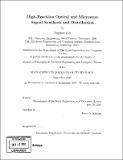High-precision optical and microwave signal synthesis and distribution
Author(s)
Kim, Jung-Won, 1976-
DownloadFull printable version (10.83Mb)
Other Contributors
Massachusetts Institute of Technology. Dept. of Electrical Engineering and Computer Science.
Advisor
Franz X. Kärtner.
Terms of use
Metadata
Show full item recordAbstract
In this thesis, techniques for high-precision synthesis of optical and microwave signals and their distribution to remote locations are presented. The first topic is ultrafast optical pulse synthesis by coherent superposition of mode-locked lasers. Timing and phase synchronization of ultrabroadband Ti:sapphire and Cr:forsterite mode-locked lasers is studied. Subfemtosecond (<0.4 fs) timing synchronization over 12 h is demonstrated. In addition to the timing lock, phase synchronization to a local oscillator with subfemtosecond accuracy (<0.5 fs) over 1000 s is achieved. Drift-free subfemtosecond timing and phase synchronization enables a phase-coherent spectrum over 1.5 octaves that has a potential to generate single-cycle optical pulses at 1 pm. The second topic is long-term stable microwave signal synthesis from mode-locked lasers. Although mode-locked lasers can produce ultralow-noise microwave signals as a form of optical pulse trains, the transfer of stability from optical to electronic domain is a highly non-trivial task. To overcome the limitations of conventional photodetection, an optoelectronic phase-locked loop based on electro-optic sampling with a differentially-biased Sagnac-loop is proposed. Long-term (>1 h) 3-mrad level phase stability of a 10.225 GHz microwave signal extracted from a mode-locked laser is demonstrated. The third topic is timing stabilized fiber links for large-scale timing distribution. Precise optical timing distribution to remote locations can result in synchronization over long distances. In doing so, acoustic noise and thermal drifts introduced to the fiber links must be canceled by a length-correction feedback loop. A single type-II phase-matched PPKTP crystal is used to construct a compact and self-aligned balanced optical cross-correlator for precise timing detection. (cont.) Using this correlator, a 310 m long fiber link is stabilized with long-term sub-10 fs accuracy. The final topic is photonic analog-to-digital conversion of high-frequency microwave signals. Sampling of high-frequency (>10 GHz) microwave signals is challenging due to the required aperture jitter below 100 fs. An optical subsampling down- converter for analog-to-digital conversion of narrowband high-frequency microwave signals is studied. The measured signal to noise-and-distortion ratio of 1-Mbps signals at 9.5 GHz carrier frequency is 22 dB over 2 MHz bandwidth. By integrating the demonstrated techniques, large-scale femtosecond-precision timing distribution and synchronization systems can be implemented.
Description
Thesis (Ph. D.)--Massachusetts Institute of Technology, Dept. of Electrical Engineering and Computer Science, 2007. Includes bibliographical references (p. 135-148).
Date issued
2007Department
Massachusetts Institute of Technology. Department of Electrical Engineering and Computer SciencePublisher
Massachusetts Institute of Technology
Keywords
Electrical Engineering and Computer Science.